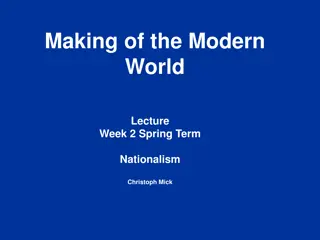Exploring Femininity in Netflix's "Navillera" Drama Series
Discussions on femininity in relation to gender expectations and cultural constructs are explored in the context of the Netflix drama series "Navillera." Using a qualitative approach, the research delves into the representation of feminine qualities and how they are depicted in the series. Various theoretical frameworks are applied to analyze the portrayal of femininity within the show.
Download Presentation
Please find below an Image/Link to download the presentation.
The content on the website is provided AS IS for your information and personal use only. It may not be sold, licensed, or shared on other websites without obtaining consent from the author. Download presentation by click this link. If you encounter any issues during the download, it is possible that the publisher has removed the file from their server.
Presentation Transcript
Representation of Femininity in the Netflix Drama Series Navillera No. Abstract: ABS-ICOLLITE-23080 Bella Rizky Ananda, Meutia Khaliya, M.Hum. Universitas Pendidikan Indonesia
INTRODUCTION When discussing femininity, it inevitably becomes intertwined with discussions about gender. The term gender represents a concept that classifies feminine and masculine qualities, which are socially and culturally constructed and can vary across different cultures. Gender encapsulates the cultural expectations placed upon women and men, is not universally applicable, and is not permanent; hence, it can undergo changes over time. In other words, the concept of gender serves as a cultural construct aimed at establishing distinctions in terms of roles, positions, behaviors, mentalities, and emotional characteristics between women and men within a society (Iswary, 2010:42).
METHOD This research uses a qualitative approach with a descriptive method. The qualitative approach describes or explains how an object can be used as research material. This research is also a type of descriptive research that thoroughly describes the content and aims to systematically process data in a factual and accurate manner regarding specific population facts and characteristics. In Barthes' theory, the analysis is divided into several stages: denotation, connotation, and myth. The denotation system is the first-level sign system, consisting of a chain of signifiers and signifieds, which is the relationship between the materiality of the signifiers and the abstract concepts behind them. At the denotation level, language reveals social codes where the meaning of the sign immediately becomes apparent on the surface based on the relationship between the signifier and the signified. On the other hand, at the connotation level, language presents hidden (implicit) codes of meaning. These hidden meanings are considered by Barthes as areas of ideology or mythology. According to Barthes, in images or photos, connotation can be distinguished from denotation. Denotation is what is depicted in the photo, while connotation is how the photo is taken. Meanwhile, according to Barthes, myths are specific values or guidelines that apply within a certain period of time. Barthes states that myths are not eternal because with the passage of time, the meaning of what is considered a value or guideline may no longer apply in the following period.
LITERATURE REVIEW 1. Juliastuti (2004:4) representation originates from the English language, derived from the term "representation," which conveys the meanings of representation, depiction, or portrayal. According to Stuart Hall, two types of representation exist. Firstly, mental representation refers to the concept that exists within our individual minds (conceptual map), which remains in an abstract form. Secondly, "language" plays a significant role in the construction process. The abstract concepts in our minds need to be translated into a common language to establish connections between our ideas and specific symbolic signs. 2. Kurnia (2004:20) feminine or femininity embodies qualities that reflect the inherent nature of women. These qualities typically encompass gentleness, patience, kindness, and other feminine traits. Masculinity, on the other hand, is associated with male attributes such as strength, bravery, adventurousness, a penchant for challenges, and other masculine traits. 3. Iswary (2010:42) gender encapsulates the cultural expectations placed upon women and men, is not universally applicable, and is not permanent; hence, it can undergo changes over time. In other words, the concept of gender serves as a cultural construct aimed at establishing distinctions in terms of roles, positions, behaviors, mentalities, and emotional characteristics between women and men within a society.
FINDING AND DISCUSSION The following investigation centers on the examination of dialogues, conversations, and utterances in Navillera drama series scenes concerning the manifestation of feminism in male characters: Feminism in this scene is evident through Sim Deok- chul's intention to pursue his dream of becoming a ballerino. There is a prevailing myth in society that ballet dancing is predominantly done by women. In Figure 1, there is a scene where Sim Deok-chul says, which means "I want to dance ballet wholeheartedly." Sim Deok- chul, dressed neatly, arrives at a ballet studio and speaks to a ballerino named Ki Seung-ju, requesting permission to join his ballet class in order to fulfill his ultimate dream. However, during their conversation, Ki Seung-ju refuses to admit Sim Deok-chul into his class, as the place is a private training space and not an academy. However, in Figure 2, Sim Deok-chul remains undeterred and says, which means "I will not come to give up with just one refusal." Figure 1. Sim Deok-chul arrives at the ballet venue. Figure 2. Sim Deok-chul is determined and never gives up.
FINDING AND DISCUSSION In Figure 3, Sim Deok-chul's wife says, , ? which means "Is it because there is nothing else to do that you're dancing ballet?" This scene strongly opposes what Sim Deok-chul is doing. In this scene, there is a clear gender stereotype portrayed by Sim Deok-chul's wife, who believes that ballet dancing is more suitable and appropriate only for women, while men are not suitable at all. Therefore, in Figure 4, Sim Deok-chul's wife cuts his ballet attire in hopes that he will no longer participate in ballet training. Figure 3. Deok-chul's wife disagrees with ballet dancing practice.
FINDING AND DISCUSSION The following are the findings of a study that focuses on visual representations related to feminism in men, as depicted in the following scenes: The denotation in this scene is that Sim Deok-chul is in the bathroom wearing a newly purchased connotation is that typically only women wear tight-fitting clothes that accentuate the body. Men usually rarely wear tight clothes; they often dress in jeans and casual attire. Sim Deok-chul is proud as he looks at himself in the mirror and wears the ballet attire, demonstrating the ballet moves he knows. ballet outfit. The Figure 4. Sim Deok-chul is wearing ballet attire.
FINDING AND DISCUSSION In Figure 7, we can see femininity in men, as they follow ballet training with graceful movements reminiscent of women. The connotative sign is that graceful movements are often associated with women rather than men. Men, on the other hand, are depicted with more assertive movements. In Figure 8, the final episode of the Navillera drama series presents a visual scene that challenges gender stereotypes regarding men who dance ballet. With their sincerity and determination, Sim Deok-chul and Lee Chae-rok finally take the stage. They refuse to succumb to the judgments of others, just as Sim Deok-chul faced rejection from his wife and children but remained resilient in his practice. Eventually, his long-held dream becomes a reality. Figure 7. The ballet dancing practice Figure 8. Sim Deok-chul and Lee Chae-rok perform on stage
CONCLUSION The research findings reveal a notable transformation in the portrayal of the character Sim Deok- chul within the drama. Elements of femininity, such as physical attributes related to body shape and hairstyle, are depicted with diminished emphasis on femininity. Similarly, the character Lee Chae- rok, despite possessing a tall and slender physique, exudes an aura of masculinity through his facial features. Furthermore, there is a significant shift in the characters' roles and ambitions, although this shift does not align with the current advancements in feminist theories and movements. Within this drama series, it can be deduced that gender norms pose no impediment to achieving one's aspirations. Navillera serves as evidence that ballet dancing is not exclusively confined to women, as men too can excel in this art form. Despite ballet predominantly attracting female participants, it is undeniable that men can also exhibit exceptional prowess in this artistic discipline. Therefore, this drama effectively conveys to its audience that social transformation can originate from within oneself.
REFERENCES Afini, A. V. (2021). Reprentasi Feminitas di Tubuh Laki-Laki dalam Film Leng Apa Jengger. Anindya, A. (2019). Feminisme dan Stereotip Gender dalam Iklan. JESS (Journal of Education on Social Science). Asrini, V., & Dhamayanti, M. (2017). Representasi Laki-Laki dalam Perspektif Men Doing Feminism dalam Program Reality Show My Daddy My Hero. UBM Journal (Universitas Bunda Mulia Jakarta). Harinanda, S. A., & Junaidi, A. (2021). Representasi Feminisme Pada Film Disney Live-Action Mulan. Koneksi. Liyanti, Y., & Ekowati P, S. (2022). Representasi Feminisme dalam Film (Studi Analisis Model Ronald Barthes dalam Film Moxie). IKON Jurnal Ilmu Komunikasi 2022 (Universitas Persada Indonesia Y.A.I). Lustyantie, N. (2012). Pendekatan Semiotika Model Roland Barthes dalam Karya Sastra Prancis. Nabilla, F. (2021, Maret 25). Sinopsis Drama Korea Navillera, Pria 70 Tahun yang Ingin jadi Balerino. Retrieved from Suara.com: https://www.suara.com/entertainment/2021/03/25/120229/sinopsis-drama-korea-navillera-pria-70-tahun-yang-ingin-jadi-balerino Sinopsis Navirella, Upaya Mengejar Mimpi Menjadi Penari Balet. (2021, Maret 24). Retrieved from CNN Indonesia: https://www.cnnindonesia.com/hiburan/20210323120022-220-620906/sinopsis-navillera-upaya-mengejar-mimpi-menjadi-penari-balet Sasmita, U. (2017). Representasi Maskulinitas Dalam Film Disney Moana (Analisis Semiotika Charles Sanders Pierce). Jurnal Online Kinesik Vol. 4 No. 2. Winarsih, S., & Putri, D. M. (2017). Representasi Feminisme dalam Media Untuk Pria Talkmen.com. Journal Communication Spectrum. Yustiana, M., & Junaedi, A. (2019). Representasi Feminisme dalam Film Marlina si Pembunuh dalam Empat Babak (Analisis Semiotika Roland Barthes). Koneksi.

















































